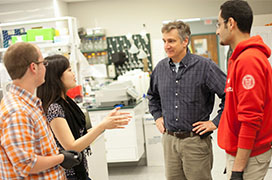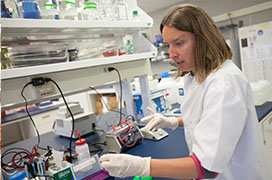Joining Forces Against Mammary Cancer

Mammary cancer strikes both humans and animals, but once the tumors are surgically removed, there are few specific drugs available to prevent the cancer from coming back. Two faculty members at the Baker Institute have joined forces to test a new therapy for treating this common form of cancer in pets and humans alike. The early results are promising and the drug may be headed to clinical trials in animals soon.

Known as breast cancer in humans and mammary cancer in animals, these cancers are common regardless of the name. At a cellular level, mammary tumors in dogs and cats are very similar to human breast cancer tumors, and they may occur in pets even more often than they do in humans: unspayed dogs can have as high as a 26 percent chance of developing mammary cancer and the disease represents the third most common cancer in cats.
 For years, Dr. Scott Coonrod has worked to identify targets in breast cancer cells that could be attacked with specific drugs. PAD enzymes present one such target. A type of bioactive molecule that plays a role in estrogen signaling, PAD enzymes control an important messaging system in many breast cancer cells. Coonrod’s collaborator at the University of Massachusetts, Dr. Paul Thompson, developed a series of inhibitors that block the action of these enzymes in the hopes they might stop breast cancer cells from dividing and growing. Coonrod and his team tested the potential drugs in cultures of human tumor cells and in mice with mammary cancer. The results for one particular PAD inhibitor, BBCLA were exciting, Coonrod says.
For years, Dr. Scott Coonrod has worked to identify targets in breast cancer cells that could be attacked with specific drugs. PAD enzymes present one such target. A type of bioactive molecule that plays a role in estrogen signaling, PAD enzymes control an important messaging system in many breast cancer cells. Coonrod’s collaborator at the University of Massachusetts, Dr. Paul Thompson, developed a series of inhibitors that block the action of these enzymes in the hopes they might stop breast cancer cells from dividing and growing. Coonrod and his team tested the potential drugs in cultures of human tumor cells and in mice with mammary cancer. The results for one particular PAD inhibitor, BBCLA were exciting, Coonrod says.
 “In cell culture the inhibitor prevents the growth of breast cancer cells but doesn’t affect the growth of normal cells, and in mice it suppresses tumor growth and is well-tolerated,” says Coonrod. This ability to specifically target cancer cells is a crucial feature for drug development, since drugs that leave normal cells alone might cause fewer side effects.
“In cell culture the inhibitor prevents the growth of breast cancer cells but doesn’t affect the growth of normal cells, and in mice it suppresses tumor growth and is well-tolerated,” says Coonrod. This ability to specifically target cancer cells is a crucial feature for drug development, since drugs that leave normal cells alone might cause fewer side effects.
These early results in human cells and mice made Coonrod wonder about how it might work for dogs and cats, so he turned to fellow Institute faculty member Dr. Gerlinde Van de Walle for help.
 Using her expertise in growing canine and feline cells, Van de Walle and her team tested BBCLA on normal dog and cat mammary cells and in cultures of mammary cell tumor cells from both species. Again, the compound inhibited tumor growth but left the healthy cells unharmed.
Using her expertise in growing canine and feline cells, Van de Walle and her team tested BBCLA on normal dog and cat mammary cells and in cultures of mammary cell tumor cells from both species. Again, the compound inhibited tumor growth but left the healthy cells unharmed.
“At realistic concentrations the compound is capable of killing tumor cells in cell culture assays,” says Van de Walle.
Now that the candidate drug has cleared these hurdles, Van de Walle and Coonrod hope to carry out pharmacology studies to ensure it’s safe for use in animals. After that step comes clinical trials, which will require forming a region-wide network of veterinarians and enrolling dogs and cats that have mammary tumors in a study to test how effective the drug is in real-world circumstances.
“We’re actively pursuing funding to take the research to the next level,” says Coonrod.


